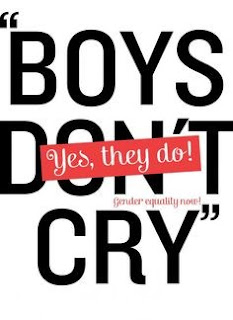Do you know this ad?
Most of us do. It was created during WWII, when the government
targeted ads toward housewives to work in the factories while all the men were
off at war. I don’t know what life was like then, but I do remember learning
about beautiful, strong, Rosie the Riveter as a child in school. She could also
be interpreted as an early feminist icon because her picture implies that women
are powerful and important to the war effort. However, I remember learning that
women after WWII were expected to go back to their housewife work, and that
many were laid off after the men returned. Therefore, the image may have just
been an attempt from the military to temporarily manipulate public opinion for
the duration of the war rather than a genuine statement of the power that women
have.
Why do I bring this ad up? Because this ad served a certain
purpose for the American population at the time. The government needed not just
men to win the war but also women to pick up the work that men couldn’t do
while off in battle. This ad and others like it encouraged women work in
factories and build aircrafts. Some women at the time became the first of their
sex to join the air force. Don’t believe me? Check it out.
Right now,
in our society, the strong woman is no longer Rosie the Riveter, but a woman who
looks more like this:
Sexy yet strong, skinny yet curvy. I love Beyoncé, don’t get
me wrong, but normal women regularly compare their sex appeal to hers, creating
a standard of beauty that is sometimes unrealistic. I searched ads for both
women and men in Google and these two image came up:
It's interesting to see
that the advertisement for Pop Chips with Katy Perry addresses a woman’s weight,
while the advertisement called "Loyalty" for a cologne came up for
men and addresses sexual desirability. The first ad, however, is about being
sexy and desirable, whereas the second one centers on obtaining a woman who is
sexy and desirable. Even though the
brands created these ads in the 2000s, they fail to challenge the popular
culture. “We don’t expect boys to be that handsome. We take them as they are. Another
added, “But boys expect girls to be perfect and beautiful. And skinny.” (P.124,
Kilbourne) This is a quote from a fourth-grade student on the double standard
she felt in school. Advertisements like these not only have effect on adults
but also on young children as well.
Advertisements
serve to influence the population in a specific way. It is easy to be
oblivious to advertisements when one is not analyzing them but rather consuming
the subliminal messages within the commercial. To truly analyze the subject of
advertising, one must have a strong stomach to handle the images of sexism,
racism, and the dominant male hierarchy that reinforced in our society. These concepts
are all fed to us naturally, but subtly, through all sorts of advertisements.
Even selling clothes or food can quickly become a sexual explicit ad.
The public may characterize these ads as
"positive" in the sense that many can see these ads and quickly
become submerged in their ideas of beauty, sexuality, and power. While that
seems to be positive for the company who has placed the ad, it proves to be
more negative in the image it has created for the person who is in the ad, and
the people whose stereotypes are reinforced by the ad.
These ads serve as an example of ads that run counter to the
dominant narrative. Even though Mercy Academy is an all-girls Catholic school
in Kentucky, they use images of Prince Charming and Snow White to tell young
women that they need life skills to get ahead rather than relying on a man to
help them. This poster is important because it targets girls at an important
time in their lives, when they are old enough to start forming identities but still
young enough to remember the gender roles in fairy tales. Seeing this ad might
get girls to question the ideals that they had been taught growing up.
“Gender inequality is worse for children, who somehow get
the misguided idea that women can do anything men can do—including compete on
an even playing field. But underneath this is the idea that gender equality is
really, really bad for men.” (P.3 kimmel) While the ad above is strong in it’s
message toward young children, I think where the advertising industry fails the
most is making real advertisements toward young boys. It is not enough to focus
on motivating girls and women to make a change but I think it is extremely
important to advertisement to young boys the importance of equality toward
women.
Reference:
http://casanovamccannblog.com/2013/11/the-new-teenage-dream-campaign/
https://socialconstructionzone.wordpress.com/2013/02/22/a-picture-is-worth-a-thousand-words/
https://www.pinterest.com/pin/183029172334100623/
https://sites.psu.edu/jaredbeyerblog/category/uncategorized/
https://www.coty.com/brands/beyonce
Beauty Beast, Jean Kilbourne
Misframing Men, Kimmel







No comments:
Post a Comment